5.11  Securing Registry Keys in Windows NT Securing Registry Keys in Windows NT
When using RegEdt32 under NT, you'll
notice a few things that differ between Windows 2000 and NT. For
starters, the Security menu has more commands in it; when you use
these commands, the user interface is different as well. However, for
the most part the underlying behavior is the same. If anything, NT is
less flexible than Windows 2000 because it doesn't have all the
same inheritance and permission controls.
5.11.1 Setting Permissions
The Security Permissions... command displays the Registry
Key Permissions dialog (see Figure 5.18). To use it,
select a key in any root key window, then give the command. When the
dialog opens, it shows which key you've selected and which
account owns it (you can't change either of them from the
dialog, however). The controls in the dialog give you access to the
permission settings for the key. Permissions... command displays the Registry
Key Permissions dialog (see Figure 5.18). To use it,
select a key in any root key window, then give the command. When the
dialog opens, it shows which key you've selected and which
account owns it (you can't change either of them from the
dialog, however). The controls in the dialog give you access to the
permission settings for the key.
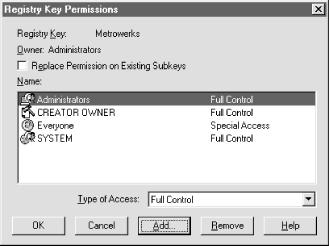
The "Replace Permission on Existing Subkeys" checkbox
tells RegEdt32 whether to apply the permission
changes you specify to all subkeys of the current key or not. When
subkeys are created, they inherit the parent key's access
controls. However, by the time you change the parent key's
access controls, the subkeys may have different controls in place.
Use this option only when you intend to override any access controls
that have been applied to subkeys. The Name field lists the current access controls in force on the key.
Each line in the list shows an account name and the DAC granted to
that account. The standard DACs are listed in Table 5.2 and Table 5.3. The Type of
Access combo box lets you change the DACs for any account in the Name
list. Changes you make are immediately reflected in the list, but
aren't applied until you click OK. The Add... button allows you to use NT's standard "Add
Users and Groups" dialog (see Figure 5.19) to
add new accounts to the ACL. The accounts you add from this dialog
appear in the Name list with Full Control as the default DAC; make
sure you change this to avoid opening a security
hole.
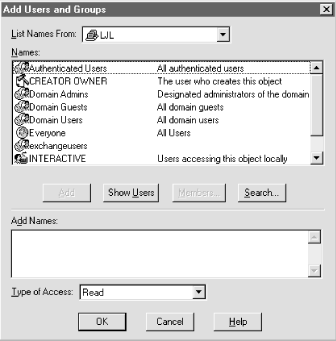
5.11.2 Auditing Registry Key Activity
Auditing allows you to keep
a trail of evidence to identify problems and pin their start down to
an exact time. NT's auditing facility lets you audit specified
actions taken by specified accounts. For example, you can audit any
attempt to change security policy by any accounts, or you could audit
failed attempts to log on by a single account. This combination of
specifying who and what makes auditing pretty flexible.
5.11.2.1 Enabling auditing on an NT machine
While auditing is useful, it also takes time. By default, NT leaves
system auditing turned off. Before you can audit Registry access (or
anything else), you have to enable auditing on the machine you want
audited.
You do this with the User Manager or User Manager for
Domains, yet another of the standard
administrative utilities NT includes to simplify your job.
Here's how to enable auditing on a single server or
workstation:
Run User Manager on the target machine. To change auditing control
settings, you have to be logged in with an account that has
Administrator privilege on the target machine. Use the Policies Audit... menu command to display the Audit
Policy dialog, shown in Figure 5.20. Audit... menu command to display the Audit
Policy dialog, shown in Figure 5.20.
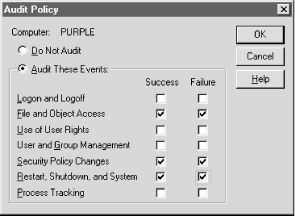
Make sure the "Audit These Events" radio button is turned
on. Otherwise, NT still happily refuses any auditing requests you
make in other applications, including
RegEdt32. Use the checkboxes to select which classes of events you want to
audit. For Registry access auditing, make sure the "File and
Object Access" checkboxes are marked. You may also want to
enable other types of auditing, but they're not strictly
necessary. Click OK, then exit the User Manager.
Once you take these steps on a machine, you won't have to do
them again; auditing on that machine will remain enabled unless you
manually turn it off using the same procedure. You do, however, have
to execute these steps on every machine for which you want to enable
auditing. Once you've done so, you can actually turn on
auditing for the Registry.
5.11.2.2 Telling RegEdt32 what to audit
The Registry Key Auditing dialog,
shown in Figure 5.21, appears when you choose the
Security Auditing... menu command. Auditing... menu command.
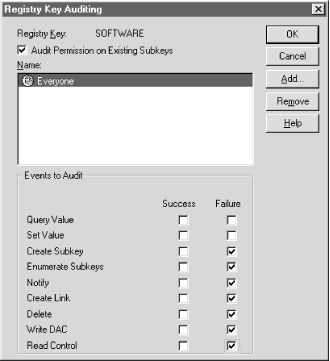
This dialog can be a little confusing at first, so a look at what its
controls do will demystify it some:
The "Registry Key" field shows you what subkey
you've selected, but it doesn't tell you what root that
subkey belongs to. You may need to move the entire Registry Key
Auditing dialog around to make sure you're auditing the key you
intended to audit. The "Audit Permission on Existing Subkeys" checkbox tells
RegEdt32 whether you want the audit changes you
specify to apply to all subkeys under the selected key or just the
selected key. If you audit all subkeys of a large root key like HKLM,
your performance will suffer. Sometimes, though, this type of shotgun
auditing is necessary so you can see which keys are being changed
when you don't know in advance which ones you need to audit. The "Name" list shows which accounts will be audited. You
can think of this list like the FBI's Most Wanted list: names
on this list are the ones scrutinized, while other names are ignored.
The Add... and Remove buttons let you change the members of this list
using an interface like the one shown in Figure 5.19. In addition to actual user accounts, you can
audit the built-in accounts like Everyone,
INTERACTIVE, and SYSTEM. The two columns of checkboxes in the "Events to Audit"
group are the meat of this dialog, since they control what actions
are logged for the specified accounts. Each of the DACs listed
earlier in Table 5.2 may be audited. When you
check a DAC's Success checkbox, the system creates an audit
record any time an account on the Name list succeeds in using that
DAC. Conversely, the Failure checkbox causes NT to generate an audit
record when a listed account tries to use the DAC and fails. For example, let's say you add the account peanut
to the audit list for HKLM\Software\Microsoft, then check
Success for Create Subkey and Failure for Write DAC. Once you save
those settings, NT generates an audit record whenever
peanut succeeds in creating a new subkey under
the selected key or fails while trying to change the DACs for an ACL
entry.
As you'd expect, the OK and Cancel buttons allow you to
preserve or discard changes you make in this dialog.
5.11.2.3 Reviewing the audit records
Once you've told
RegEdt32 what to audit, you still need to see
the audit entries that have been generated. If you're
accustomed to administering Unix machines, you're probably
familiar with the syslog service. NT has a
similar feature; it keeps an event log that applications and system
components may write to. The NT event log is actually three separate
logs: one for system data, one for application-generated data, and
one for security data. Auditing messages (no matter their source) go
into the security log.
To view these log messages, you'll need to use
Microsoft's Event Viewer application. A complete discussion of
how to use the Event Viewer is outside the scope of this book, but
the basic process is simple enough to boil down into a few concise
steps:
Launch the Event Viewer (eventvwr.exe).
There's a shortcut to it in the Start menu, too; look under
Programs Administrative Tools (Common) Administrative Tools (Common) Event
Viewer to find it. Event
Viewer to find it. When Event Viewer opens, you see a window like the one shown in Figure 5.22. Use the Log Security command
to display the security log. Security command
to display the security log.
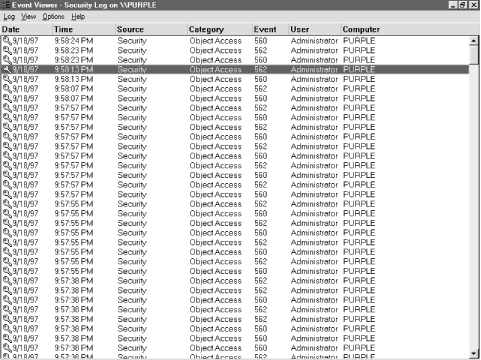
Event Viewer shows you a passel of events (the exact number depends
on how big the event log is). You can sort, filter, and view events
using the commands in the View menu. If there's a particular
event you're interested in, double-click it or use the
View Details... command to get the dialog shown in
Figure 5.23, which gives all the pertinent event
details in
one place. Details... command to get the dialog shown in
Figure 5.23, which gives all the pertinent event
details in
one place.
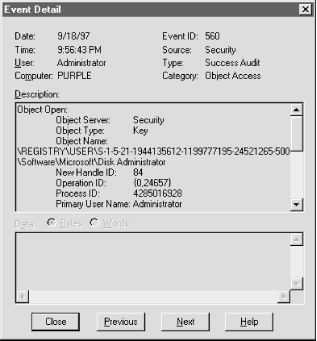
5.11.3 Changing Key Ownership
Like every other object in
NT's world, each Registry key has an owner. As with Unix, NT
allows the owner to control access to objects it owns to a certain
extent; the superuser or Administrator account can always take
ownership of an object and change its permissions when necessary. NT
does, however, provide a standard auditing mechanism that logs all
manually initiated changes of ownership, so you'll always have
an audit trail that shows when someone's taken over one of your
objects.
When you use this command, you're telling
RegEdt32 to change the owner of the currently
selected key and all its subkeys to the current account. This blanket
change of ownership can lead to unexpected behavior, since many NT
components assume they'll always have unrestricted access to
all subkeys of HKLM and many subkeys of HKCU and HKCR. However,
it's usually a good idea to set appropriate ownership of HKU
's subkeys, as well as those subkeys of HKLM that are safe to
reset. The best way to set ownership is with a utility like David
LeBlanc's everyone2user, which is
discussed in Section 9.4
in Chapter 9.
If you insist on doing it manually, RegEdt32
allows you to take ownership of Registry keys with the
Security Owner... command. The Owner dialog, pictured
in Figure 5.24, shows you what key is selected and
which account owns it. The Take Ownership button changes the
key's (and its subkeys') ownership to whatever account
you're logged in as, while the Close button cancels the command
without changing anything. Of course, if you don't have
Administrator privileges you can't take ownership of any key
you don't already own. Owner... command. The Owner dialog, pictured
in Figure 5.24, shows you what key is selected and
which account owns it. The Take Ownership button changes the
key's (and its subkeys') ownership to whatever account
you're logged in as, while the Close button cancels the command
without changing anything. Of course, if you don't have
Administrator privileges you can't take ownership of any key
you don't already own.

|